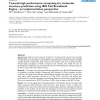Free Online Productivity Tools
i2Speak
i2Symbol
i2OCR
iTex2Img
iWeb2Print
iWeb2Shot
i2Type
iPdf2Split
iPdf2Merge
i2Bopomofo
i2Arabic
i2Style
i2Image
i2PDF
iLatex2Rtf
Sci2ools
107
click to vote
BMCBI
2010
2010
Towards high performance computing for molecular structure prediction using IBM Cell Broadband Engine - an implementation perspe
Background: RNA structure prediction problem is a computationally complex task, especially with pseudo-knots. The problem is well-studied in existing literature and predominantly uses highly coupled Dynamic Programming (DP) solutions. The problem scale and complexity become embarrassingly humungous to handle as sequence size increases. This makes the case for parallelization. Parallelization can be achieved by way of networked platforms (clusters, grids, etc) as well as using modern day multi-core chips. Methods: In this paper, we exploit the parallelism capabilities of the IBM Cell Broadband Engine to parallelize an existing Dynamic Programming (DP) algorithm for RNA secondary structure prediction. We design three different implementation strategies that exploit the inherent data, code and/or hybrid parallelism, referred to as C-Par, D-Par and H-Par, and analyze their performances. Our approach attempts to introduce parallelism in critical sections of the algorithm. We ran our experi...
| Added | 08 Dec 2010 |
| Updated | 08 Dec 2010 |
| Type | Journal |
| Year | 2010 |
| Where | BMCBI |
| Authors | S. P. T. Krishnan, Sim Sze Liang, Bharadwaj Veeravalli |
Comments (0)

